A. An Overview
1. Bacteria (= prokaryotic cells)
- Eubacteria (heterotroph)
- Archebacteria or Archaea (heterotroph)
- Cyanobacteria (phototroph, phytoplankton!)
- "real Cyanobacteria"
- filamentous cyanobacteria, fix nitrogen
- coccoid cyanobacteria
- Prochlorophytes
- Chromophyta (possess chlorophyll a and c)
- Cryptophyceae
- Dinophyceae
- Chrysophyceae
- Prymnesiophyceae
- Bacillariophyceae (diatoms)
- Chlorophyta (possess chlorophyll a and b)
- Chlorophyceae
- Prasinophyceae
- Euglenophyceae
- Plankton, benthos, and epiphyton
- Centric (round) mostly plankton
- Size 2 mm to 1 mm; single, chains, colony
- Silica frustle important in Si cycle and deposit of silica on sea floor (ooze)
- Taxonomy: based on pores in frustle
- Predominant in phytoplankton spring bloom in temperate and polar seas
- Non-motile prefer turbulent waters
- Cell division replacement of one frustle half; daughter cells become smaller; at certain size sexual reproduction, formation of auxospore
- Some species produce resting spore with thickened frustle, which rests on sea floor (shallow seas) upon adverse conditions
pennate (long) mostly benthos, epiphyton
- Also referred to as Pyrrophyta
- Can be autotrophic (phototrophic), but 50% of dinoflagellates are heterotrophic; some chlorophyll-carrying species complement nutrition by phagotrophy (mixotrophic); parasitic forms (on or within zooplankton or sucking out diatoms)
- Mostly single cells, some form chains; motile by 2 flagella
- hate turbulence
- Naked forms and thecate forms; theca consists of several thick cellulose plates
- Typically abundant in summer, fall blooms, oligotrophic (nutrient-poor) open ocean
- Proliferation by cell division, theca may divide with daughter cells building new half or may be lost prior to division
- Sexual reproduction leads to resting spores, deposited in sediment
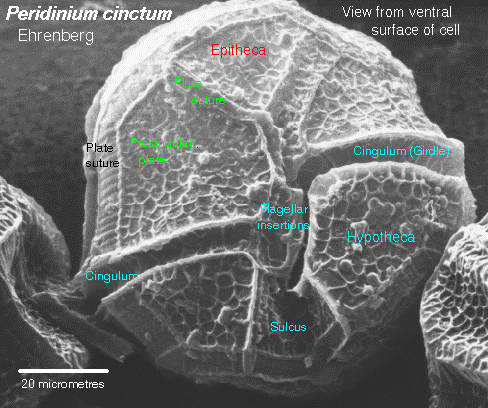
- Systematics of dinoflagellates based on number and structure of cellulose plates and spines
- Cell divided in posterior and anterior half by deep grove = girdle
- One flagellum extends free posteriorly from cell (forward movement), the other wraps transversally around cell in the girdle (rotation)
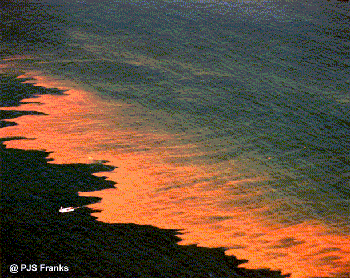
- Mass development of dinoflagellates (>108 cells l-1) discolor water; mostly related to nutrient input by rain or drainage from fields and pig/chicken farms
- Paralytic Shellfish Poisoning (PSP): Algal cells contain highly lethal saxitoxin; accumulation of toxin in clams, mussel, scallops, fish lead to poisoning of humans; symptoms neurological, heart arrest in most severe cases after 24 hrs; closure of mussel beds
- Neurotoxic Shellfish Poisoning (NSP): algal toxin is brevetoxin (Gymnodinium breve); neurological & gastrointestinal symptoms; aerosols can produce asthma; no deaths reported
- Diarrhetic Shellfish Poisoning (DSP): Okadaic acid, Dinophysis sp.; gastrointestinal symptoms (diarrhea, cramps) 30 min after consumption of toxic shellfish, not lethal, recovery ca. 3 days
- Ciguatera Fish Poisoning (CFP): Ciguatoxin, gastrointestinal, neurological, and cardiovascular symptoms; paralysis and death documented, but usually less severe; mostly tropical waters
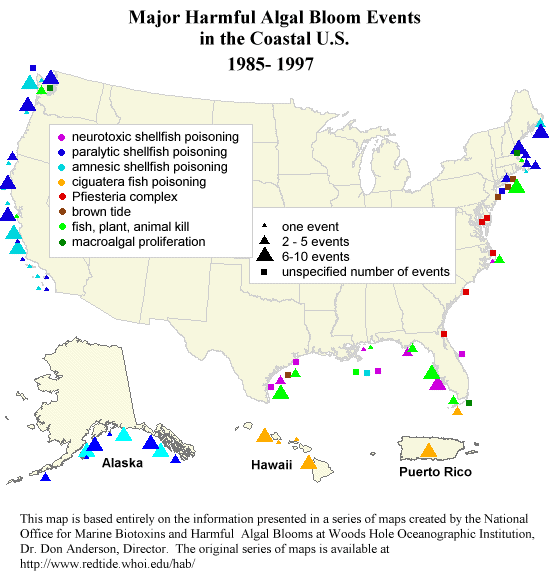
E. Prymnesiophyceae
- Major oceanic bloom formers; some mixotrophic
- Naked cells, mostly single; motile, 2 flagella and 1 haptonema (also referred to as Haptophytes)
- Phaeocystis gelatinous colony-forming, extended blooms in North Sea, Atlantic, and Southern Ocean
- Coccolithophorids: single cells with external shell of calcareous plates (coccoliths)
- only one or several plate types plates (sytematics)
- mostly <20 mm (nanoplankton)
- Blooms visible from space by discoloration
- Major transport of carbonate to the sea floor; sediments up-lifted to surface known as chalk (White Cliffs, Dover)
- Longitudinal cell division /w shell divided
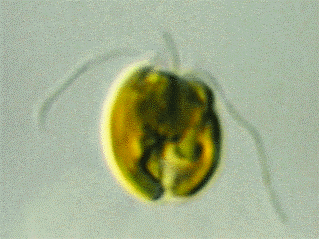
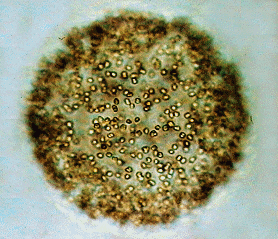
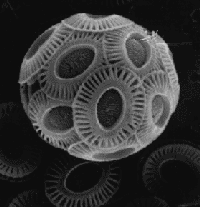
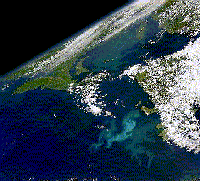
- Also referred to as golden (brown) algae;
- Usually single cells with 1 flagellum, small, few colony-forming species in freshwater
- Posses small scales on cells used for taxonomy
- Silicoflagellates: possess internal skeleton of silicous spines; few species, mostly cold water
- Marine species mostly single cells with two flagella; colony-forming, aflagellate cells abundant in freshwater
- Contain chlorophyll b, by which they can be distinguished in pigment analyses (HPLC)
- Less important in typically marine systems but abundant in Florida Bay and eutrophic coastal and estuarine areas
- Also reffered to as blue-green algae; however, they are procaryotic organisms (bacteria, no algae)
- Single cells, colonies, filaments, aggregates
- Tropical oceans: Trichodesmium (Oscillatoria) ability to fix nitrogen (N2), important for N cycle
- Baltic Sea: also blooms of filamentous, N2-fixing cyanobacteria during summer to fall (yellow and red color)
- Ubiquitous and important: Synechococcus spp. (coccoid, <2 mm size) and Prochlorococcus spp. (coccoid, 0.5 mm) major part of photosynthetic picophytoplankton
- Mats of filamentous cyanobacteria can form stromatolites in the tidal zone
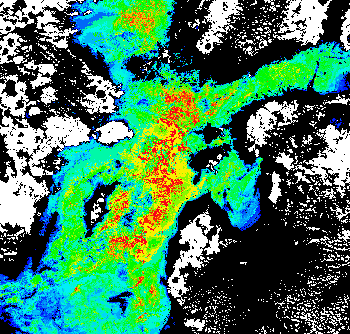
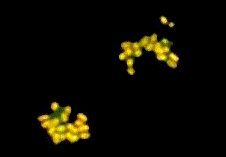
(Epifluorescence micrograph of Synechococcus)
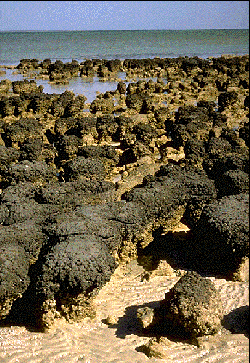
I. Links to
photo collections on the web:
- A japanese site with excellent fotos
- The Finnish Alg@line project gallery
- The diatom page
- More about dinoflagellates
- The Emiliania huxleyi (coccolithophorid) home page
- Lots on all kinds of cyanobacteria from Purdue
- Don Anderson's Red Tide Page at WHOI
- Red Tide Florida Homepage
- More red tide info
- The real Pfiesteria pages from JoAnn Burkholder